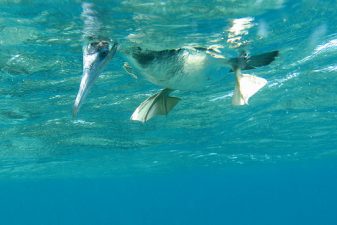 Researchers discover the negative link between Palm plantations, nesting birds and manta ray populations.
Researchers discover the negative link between Palm plantations, nesting birds and manta ray populations.
Over meals and sunset chats at a remote research station in Palmyra Atoll in the Pacific, a group of researchers from Stanford University discover one of the longest ecological interactions ever documented. While Douglas McCauley and Paul DeSalles were tracking manta ray movements for a predator-prey interaction study, Hillary Young was studying palm tree proliferation’s effects on bird communities and native habitats. Soon through discussions of their work and observations, the group of scientists began to see a link between manta ray population densities, bird communities and palm plantations.
“As the frequencies of these different conversations mixed together, the picture of what was actually happening out there took form in front of us,” says McCauley.
Through analysis of nitrogen isotopes, animal tracking and field surveys the researchers confirmed their intuitions: seabirds roosting on native trees fertilize soils, which increase coastal nutrients and the abundance of plankton, thus attracting manta rays to native forest coastlines. Instead, regions of the atoll where native trees have been replaced by human propagated palms reveal that this interaction chain linking birds to mantas readily breaks down.
In fact, replacing native trees with non-native palms led to about five times fewer roosting seabirds, which led to fewer bird droppings to fertilize the soil below, fewer nutrients washing into surrounding waters, smaller and fewer plankton in the water and fewer hungry manta rays cruising the coastline.
These findings provide a compelling example of how anthropogenic disturbance may be contributing to widespread reductions in ecological interaction chain length, thereby isolating and simplifying ecosystems. Furthermore, the study exemplifies how human disturbance is leading to widespread, yet largely invisible, disruptions of ecological interaction chains. Finally the study highlights the need to build non-traditional alliances — among marine biologists and foresters, for example — to address whole ecosystems across political boundaries in order to efficiently discover, understand and address the need to preserve “invisible” ecosystem processes.
Manta ray image from Shutterstock



